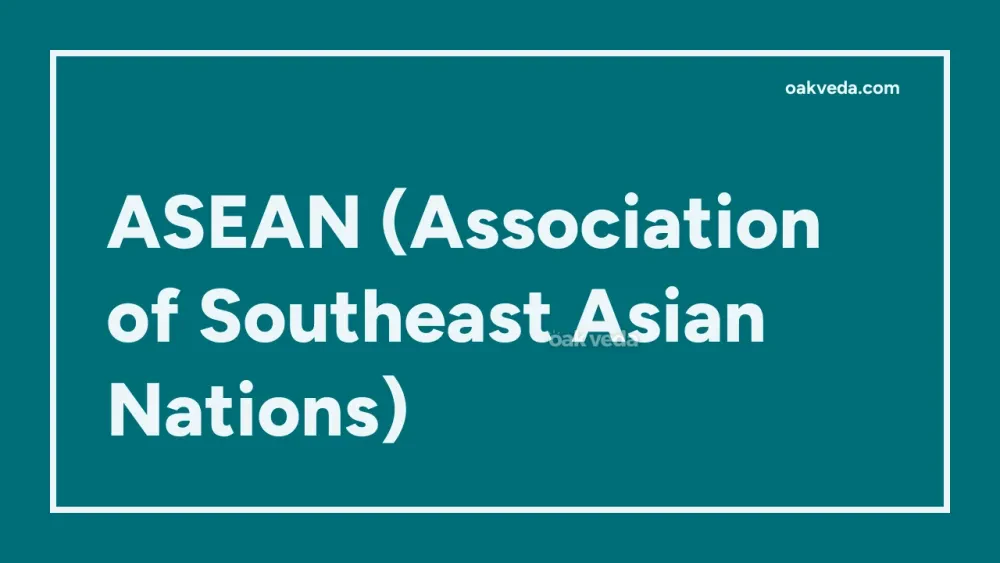
What is the Full Form of ASEAN?
ASEAN is the acronym for the Association of Southeast Asian Nations. This regional intergovernmental organization plays a crucial role in promoting cooperation and integration among its member states in Southeast Asia.
What is the Association of Southeast Asian Nations?
The Association of Southeast Asian Nations (ASEAN) is a prominent regional organization that aims to foster political, economic, security, educational, military, and socio-cultural cooperation among its member countries. Established to promote peace, stability, and prosperity in the region, ASEAN has become a significant player in global affairs.
Origin and Development of ASEAN
ASEAN was founded on August 8, 1967, in Bangkok, Thailand, by five founding members: Indonesia, Malaysia, Philippines, Singapore, and Thailand. Since its inception, the organization has expanded to include ten member states:
- Brunei (joined in 1984)
- Vietnam (joined in 1995)
- Laos (joined in 1997)
- Myanmar (joined in 1997)
- Cambodia (joined in 1999)
The organization's development has been marked by several key milestones:
- In 1976, member nations signed the Treaty of Amity and Cooperation, emphasizing the importance of peace, friendship, and cooperation.
- The ASEAN Free Trade Area (AFTA) was established in 1992 to promote economic integration.
- The ASEAN Charter, signed in 2007, provided a legal framework for the organization and established ASEAN as a legal entity.
How does ASEAN work?
ASEAN operates on the principle of consensus-based decision-making, known as the "ASEAN Way." This approach emphasizes consultation, non-interference in internal affairs, and peaceful resolution of disputes. The organization holds regular summits and ministerial meetings to discuss regional issues and formulate policies.
Functions of ASEAN
ASEAN serves several crucial functions in the Southeast Asian region:
- Economic cooperation: Promoting trade, investment, and economic integration among member states.
- Political and security cooperation: Addressing regional security challenges and maintaining peace.
- Socio-cultural cooperation: Fostering people-to-people connections and cultural exchanges.
- External relations: Engaging with dialogue partners and other international organizations.
Applications of ASEAN
ASEAN's influence extends to various areas of regional cooperation:
- Trade: The ASEAN Free Trade Area (AFTA) has significantly reduced tariffs and promoted intra-regional trade.
- Diplomacy: ASEAN serves as a platform for dialogue and conflict resolution in the region.
- Tourism: The organization promotes Southeast Asia as a single tourist destination through initiatives like the ASEAN Tourism Forum.
- Education: ASEAN University Network (AUN) fosters cooperation among higher education institutions in the region.
Features of ASEAN
Key features that define ASEAN include:
- Diversity: ASEAN embraces the diverse cultures, religions, and political systems of its member states.
- Non-interference: The organization respects the sovereignty of its members and avoids interfering in domestic affairs.
- Consensus-building: Decisions are made through consultation and consensus rather than majority voting.
- Open regionalism: ASEAN engages with external partners through initiatives like ASEAN+3 and the East Asia Summit.
Benefits of ASEAN
ASEAN has brought numerous benefits to its member states and the region:
- Economic growth: Increased trade and investment have contributed to the economic development of member countries.
- Regional stability: ASEAN has played a crucial role in maintaining peace and security in Southeast Asia.
- Enhanced bargaining power: As a collective, ASEAN countries have a stronger voice in international affairs.
- Cultural exchange: The organization promotes understanding and cooperation among diverse cultures.
Limitations or Challenges of ASEAN
Despite its successes, ASEAN faces several challenges:
- Disparities in development: Economic and social gaps between member states can hinder integration efforts.
- Consensus-based decision-making: While promoting harmony, this approach can sometimes lead to slow progress on critical issues.
- South China Sea disputes: Territorial conflicts in the region test ASEAN's ability to maintain unity and resolve disputes.
- Human rights concerns: Critics argue that ASEAN's non-interference principle sometimes impedes addressing human rights issues.
Future Developments in ASEAN
As ASEAN moves forward, several key areas of focus emerge:
- Digital transformation: Embracing the Fourth Industrial Revolution and promoting digital integration across the region.
- Sustainable development: Addressing climate change and environmental challenges through collaborative efforts.
- Strengthening the ASEAN Community: Deepening integration in economic, political-security, and socio-cultural pillars.
- Enhanced global partnerships: Expanding cooperation with dialogue partners and other regional blocs.
FAQs on ASEAN Full Form
-
What does ASEAN stand for? ASEAN is the full form of the Association of Southeast Asian Nations.
-
How many countries are in ASEAN? ASEAN consists of ten member states.
-
When was ASEAN founded? ASEAN was established on August 8, 1967.
-
What is the purpose of ASEAN? ASEAN aims to promote regional cooperation, peace, stability, and prosperity among Southeast Asian nations.
-
Where is the ASEAN headquarters located? The ASEAN Secretariat is based in Jakarta, Indonesia.
In conclusion, ASEAN has played a pivotal role in shaping the political, economic, and social landscape of Southeast Asia. As the organization continues to evolve, it faces both opportunities and challenges in its quest to create a more integrated and prosperous region. Understanding the full form and functions of ASEAN is crucial for anyone interested in Southeast Asian affairs and regional cooperation.
You may be interested in:
- BMD (Bone Mineral Density): Full Form Explained
- USP (Unique Selling Proposition): Full Form Explained
- CPU (Central Processing Unit): Full Form and Function
- CFT (Complement Fixation Test): Full Form Explained
- ICWA (Indian Child Welfare Act): Full Form Explained
- TT (Tetanus Toxoid): Full Form and Importance

